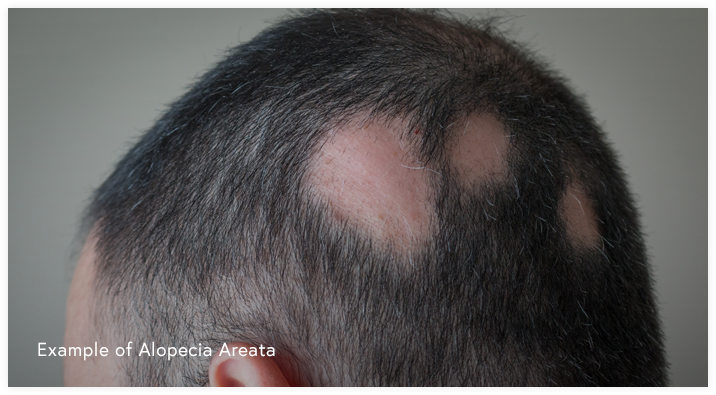Alopecia Areata
Hair follicles are created before birth and remain constant throughout life. There are about 100,000 – 150,000 scalp hair follicles at birth. But not all follicles become active at the same time, and some lose the ability to produce hair over time.
Active follicles have a normal life cycle that includes a growth phase, followed by a transitional phase, and then a resting phase. In fact, hair grows one centimeter a month! And, not all hair follicles are active at the same time. The life cycle of hair follicles can be as long as seven years or as short as two years. The cycle ends when the hair is shed.
See an example of Alopecia Areata below:

What is Alopecia Areata?
Alopecia Areata is the medical term for hair loss. There are many types of hair loss caused by a variety of conditions from autoimmune diseases to the use of certain medications.
Temporary hair loss can result from giving birth or from severe stress. Hair loss may be reversible or reverse on its own. Permanent hair loss is commonly caused by androgenetic alopecia areata or hereditary hair loss affects men and women. Everyone loses 50 – 100 scalp hairs each day. Usually, those hairs grow back.
Causes of Alopecia Areata
- Changes in hair color and thickness are some of the most obvious signs of aging. As we age, the rate of hair growth slows down and the hair follicles age too. Some hair loss is expected with aging because the hair is shed faster than it grows back. Once thick, healthy hairs fall out and are replaced by thinner, less pigmented hair, as the follicles wear out.
- Androgenetic alopecia areata is inherited hair loss caused by a genetic predisposition to hormones that damage the hair follicles. Androgenetic alopecia areata is the most common cause of hair loss and shows as a receding hairline from the forehead in an M pattern. Women usually retain their hairline, but have a broadening of their central part, and overall thinning.
Contrary to popular belief, hereditary hair loss is not from the mother or mother’s father. Rather, multiple genes have been identified as causing male pattern hair loss and female pattern hair loss.
- Autoimmune disease. Alopecia Areata is an autoimmune disease that causes smooth, round patches of hair to fall out. It affects the scalp and can affect the beard and eyebrows. The skin may be itchy or painful.
- Disease and underlying conditions. Losing your hair may be the first sign of 30 different diseases. Common diseases like thyroid disease and anemia can cause the hair to fall out. Diabetes and lupus are related to hair loss. Treating the underlying disease can stop or reverse hair loss.
- Major surgery, high fever, severe infections, and scalp infections interfere with normal hair cycles. The hair usually grows back.
- Cancer treatments like radiation and chemotherapy can cause hair loss on the head, and over the entire body. The hair usually grows back.
- Sudden, intense emotional or physical distress can cause a temporary loss of hair.
- Hormone changes in pregnancy, childbirth, and menopause can cause temporary or permanent hair loss.
- Drug-induced hair loss. Certain medications used to treat cancer, depression, heart problems, epilepsy, gout, and blood pressure can interfere in the normal cycle of hair growth.
- Traction alopecia areata is caused by hairstyles that pull the hair tight including ponytails, pigtails, and cornrows.
- Hair loss is associated with rapid weight loss. Stress to the system forces hair follicles into the resting phase. When the stressors are removed, normal hair growth will return.
- Dietary changes and nutritional deficiencies like low iron can cause hair loss.
Preventative Hair Loss Treatment
- Rogaine
- Finastride
- Supplements
Restorative Hair Loss Treatment
- FUE
